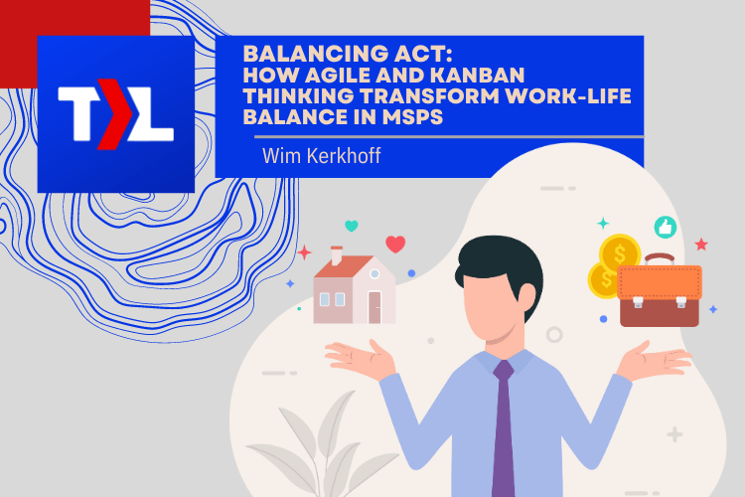Maintaining a healthy work life balance in the fast-paced world of Managed Service Providers (MSPs) can often seem like a distant dream. The demands of customers, the ever-evolving technology landscape, and the urgency of solving problems can make it challenging for employees to find balance. However, there is a silver lining: integrating Agile and Kanban thinking is changing the way MSPs operate, leading to improved work-life balance for their dedicated teams. In this blog post we explore how MSP employees reconcile their professional and personal lives by embracing these methods on how to be empowered to regain emotion .
1. Prioritization and Focus
Agile and Kanban methodologies emphasize the prioritization of tasks based on value and urgency. By focusing on the real high-priority tasks, employees can make better use of their time and energy. This approach reduces the pressure of dealing with an enormous number of tasks, allowing employees to allocate sufficient time for work and personal activities
2. Stress Reduction Through Transparency
Transparency is a core principle of Agile and Kanban methodologies. Visualizing workflows on Kanban boards and engaging in regular Agile ceremonies promotes clear communication and shared understanding. Reduced ambiguity and improved communication contribute to lower stress levels among employees, as they can better anticipate and manage their workload.
3. Smarter Time Management
Agile's time-boxed iterations and Kanban's focus on limiting work in progress encourage employees to manage their time more efficiently. Time-boxed sprints help prevent overworking and burnout, and setting WIP limits ensures that employees are not overwhelmed with too many tasks at once. This promotes healthier time management practices, which directly impact work-life balance.
4. Adaptability to Personal Needs
The Agile mindset embraces adaptability. Employees who follow Agile principles are empowered to address personal needs without the fear of derailing the team's progress. This adaptability extends to accommodating flexible work hours, remote work arrangements, and personal commitments, allowing employees to create a harmonious blend of work and personal life.
5. Continuous Improvement in Process Efficiency
Agile and Kanban methodologies encourage a culture of continuous improvement. As processes become more efficient, employees can achieve more within a standard workday. Reduced time spent on repetitive or low-value tasks leaves room for engaging in personal activities, contributing to better work-life balance.
6. Clearer Boundaries
Kanban's visualization of work stages and Agile's well-defined iterations help set clearer boundaries for work. When employees see tasks moving through stages, they gain a better understanding of progress. This, in turn, allows them to detach from work during designated non-working hours, enhancing their personal lives.
7. Enhanced Collaboration and Knowledge Sharing
Agile emphasizes collaboration and cross-functional teamwork. When teams collaborate effectively, individual employees do not bear the weight of tasks alone. This not only improves work quality but also enables employees to disconnect from work without feeling solely responsible for tasks in progress.
8. Positive Impact on Morale and Engagement
By fostering a culture that values work-life balance and personal well-being, Agile and Kanban methodologies contribute to higher employee morale and engagement. Employees who feel their well-being is valued by the organization are more likely to be motivated and productive.
9. Autonomy and Empowermen
Both Agile and Kanban methodologies empower employees to make decisions and manage their own work. This autonomy allows employees to shape their work in a way that suits their strengths, preferences, and personal commitments, promoting a healthier balance between work and life.
10. Increased Job Satisfaction
Ultimately, employees who experience a healthier work-life balance tend to have higher job satisfaction. A supportive work environment that embraces Agile and Kanban principles enhances the overall well-being of employees, fostering loyalty and longevity within the organization.
--
In conclusion, the integration of Agile and Kanban thinking goes beyond improving workflows—it transforms work-life balance for employees in MSPs. By prioritizing tasks, promoting transparency, and encouraging adaptability, these methodologies empower employees to take charge of their time and find harmony between their professional and personal lives. As MSPs embrace these principles, they create an environment where employees can thrive, leading to enhanced productivity, job satisfaction, and a brighter future for both individuals and the organization as a whole.
Want to know more about how other project managers and service managers are taking advantage of Topleft's swim lanes? Watch our Panel Discussion 2 on Teamwork Transformer below, or Book a demo now to get first-hand visibility on how TopLeft can take your PSA tools to the next level.
Panel Discussion 2: Teamwork Transformer
